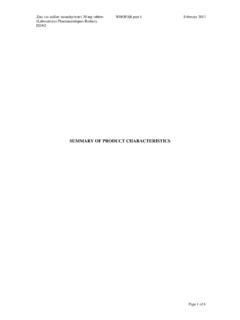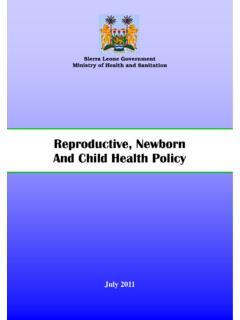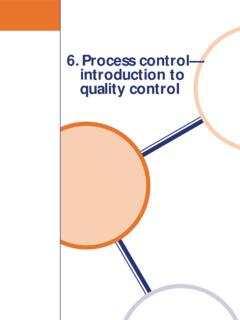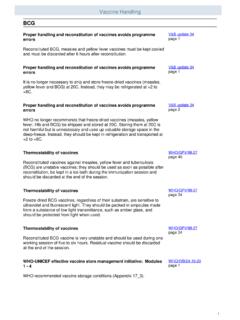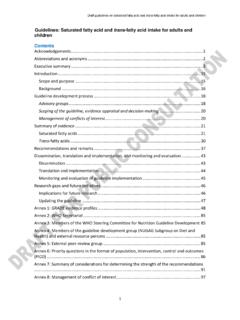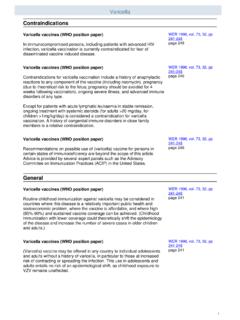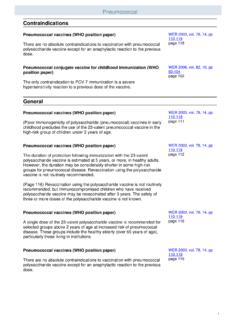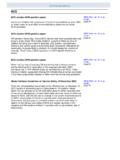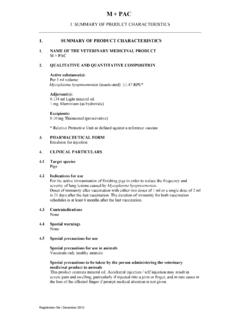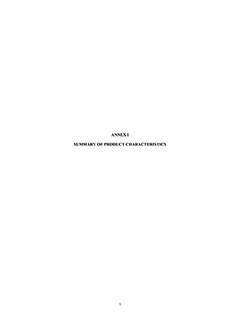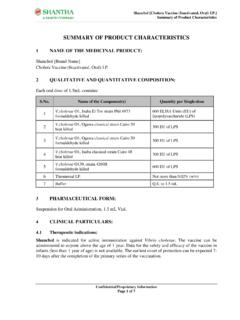Transcription of SUMMARY OF PRODUCT CHARACTERISTICS
1 Artesunate 60 mg for injection WHOPAR part 4 June 2013 (Guilin Pharmaceutical Co., Ltd.), MA051 SUMMARY OF PRODUCT CHARACTERISTICS page 1 of 12 Artesunate 60 mg for injection WHOPAR part 4 June 2013 (Guilin Pharmaceutical Co., Ltd.), MA051 1. NAME OF THE MEDICINAL PRODUCT Artesun * 2. QUALITATIVE AND QUANTITATIVE COMPOSITION Each vial contains: artesunate powder 60 mg Each ampoule of solvent contains: sodium bicarbonate 50 mg/ml, 1 ml Each ampoule of diluent contains: sodium chloride 9 mg/mL, 5mL 3. PHARMACEUTICAL FORM Artesunate for injection: White crystalline powder Solvent (sodium bicarbonate injection): Clear, colourless liquid 4. CLINICAL PARTICULARS Therapeutic indication Artesun , administered intravenously or intramuscularly, is indicated for the treatment of severe malaria caused by Plasmodium falciparum, in adults and children Posology and method of administration Dose: Adults and children: Artesun is administered at a dose of mg of artesunate / kg body weight, by intravenous (IV) or intramuscular (IM) injection, at 0, 12 and 24 hours, then once daily until oral treatment can be substituted.
2 Artesun should be administered for a minimum of 24 hours (3 doses), regardless of the patient s ability to tolerate oral medication earlier. After at least 24 hours of Artesun , and when able to tolerate oral medication, the patient should be switched to a complete treatment course of an oral combination antimalarial regimen. Relevant treatment guidelines should be consulted when selecting an appropriate regimen ( those of the WHO: ). Preparation Because of the instability of artesunate in aqueous solutions the reconstituted solution must be used within one hour of preparation. Therefore the required dose of artesunate should be calculated (dose in mg = patient s weight in kg x ) and the number of vials of artesunate needed should be determined prior to reconstituting the artesunate powder. _____ *Trade names are not prequalified by WHO.
3 This is the national medicines regulatory authority s (NMRA) page 2 of 12 Artesunate 60 mg for injection WHOPAR part 4 June 2013 (Guilin Pharmaceutical Co., Ltd.), MA051 responsibility. Throughout this WHOPAR the proprietary name is given as an example only. Reconstitution of the artesunate solution Using a syringe, withdraw 1 ml of the supplied sodium bicarbonate solvent from the ampoule and inject into the vial containing the artesunate powder. Shake the vial for several minutes to mix well until the powder is completely dissolved and the solution is clear. If the solution appears cloudy or a precipitate is present, it should be discarded. The reconstituted artesunate solution should always be used immediately, and discarded if not used within one hour. Following reconstitution the solution must be diluted according to the method of injection, as described below.
4 For intravenous (IV) injection Using a syringe, add 5 ml of sodium chloride for injection to the vial containing the reconstituted artesunate solution. This will yield 6 ml of a solution containing artesunate 10 mg/ml. Shake to mix well, ensuring that the resulting solution is still clear. If the solution appears cloudy or a precipitate is present, it should be discarded. The volume required will be equal to: (desired dose in mg) ml 10 Withdraw the required volume of artesunate solution from the vial with a syringe and then inject slowly intravenously, the speed of IV consistent with slow bolus: 3- 4 ml/min. Artesun should NOT be administered as an intravenous drip. For intramuscular (IM) injection Using a syringe, add 2 ml of sodium chloride for injection to the vial containing the reconstituted artesunate solution.
5 This will yield 3 ml of a solution containing artesunate 20 mg/ml. Shake to mix well, ensuring that the resulting solution is still clear. If the solution appears cloudy or a precipitate is present, it should be discarded. The volume required will be equal to: (desired dose in mg) ml 20 Withdraw the required volume of artesunate solution from the vial with a syringe and then inject intramuscularly; the anterior thigh is usually the preferred site for injection. If the total volume of solution to be injected intramuscularly is large, it may be preferable to divide the volume and inject it at several sites, both thighs. Do not use water for injection for reconstitution of the artesunate powder or for dilution of the resulting solution prior to injection.
6 Hepatic and renal impairment: Dose adjustment is not necessary in patients with hepatic or renal impairment (see Sections and ). Contraindications Artesun is contraindicated in patients with hypersensitivity to artesunate or other artemisinins. Special warnings and precautions for use Non-falciparum malaria page 3 of 12 Artesunate 60 mg for injection WHOPAR part 4 June 2013 (Guilin Pharmaceutical Co., Ltd.), MA051 Artesunate has not been evaluated in the treatment of severe malaria due to Plasmodium vivax, Plasmodium malariae or Plasmodium ovale. Switching to oral treatment regimen Acute treatment of severe falciparum malaria with Artesun should always be followed by a complete treatment course of an appropriate oral combination antimalarial regimen (see Section ) Resistance to antimalarials Local information on the prevalence of resistance to antimalarials should be considered in choosing the appropriate combination antimalarial regimen for use with Artesun.
7 Relevant treatment guidelines should be consulted ( those of the WHO: ). Post-treatment anaemia Despite transient decreases in reticulocyte counts, clinically significant anaemia associated with IV artesunate has not been common in clinical trials. However, occasional cases of post-treatment haemolytic anaemia severe enough to require transfusion have been reported (see Section ). Hepatic / renal impairment: Data regarding artesunate pharmacokinetics in patients with hepatic and/or renal impairment are limited. Based on data from studies in patients with severe malaria, as well as the known metabolism of artesunate (see Section ), dosage adjustment is not considered necessary in patients with hepatic or renal impairment. Paediatric population In clinical trials, the efficacy and safety of intravenous and intramuscular artesunate have been similar in adult and paediatric populations.
8 Interaction with other medicinal products and other forms of interaction Artesunate is rapidly and extensively converted to dihydroartemisinin (DHA), the active metabolite, primarily by plasma and erythrocyte esterases. DHA elimination is also rapid (half-life approximately 45 min) and the potential for drug-drug interactions appears limited. In vitro drug-interaction studies have demonstrated minimal effects of artesunate on cytochrome P450 isoenzymes. Few clinical drug-drug interaction studies have been performed, however no clinically significant interactions have been identified. Pregnancy and lactation Pregnancy Severe malaria is especially hazardous during pregnancy, therefore full dose parenteral antimalarial treatment should be administered without delay. There has been limited clinical experience with the use of artesunate in pregnancy.
9 In animal studies, artesunate has been associated with foetal toxicity during the first trimester of pregnancy. To date, clinical data regarding safety in the first trimester have not indicated an increased risk of foetal harm. Treatment with artesunate should not be withheld during the first trimester if it is potentially page 4 of 12 Artesunate 60 mg for injection WHOPAR part 4 June 2013 (Guilin Pharmaceutical Co., Ltd.), MA051 life-saving for the mother. As in other populations, the evidence that artesunate reduces the risk of death from severe malaria compared to other treatments should be borne in mind. In a study of 461 pregnant Thai women (44 in their first trimester) who were treated with artemisinins (predominantly artesunate), there was no obvious evidence of adverse effects amongst the 414 women for whom pregnancy outcomes were known.
10 The observed rates of abortion, stillbirth, congenital anomalies and low birth weight were comparable to community rates. In clinical trials from 1999 to 2006, 2,045 pregnant women in Thailand, the Gambia, and Sudan were treated with artesunate, either alone or in combination with other antimalarials, including quinine, mefloquine, atovaquone-proguanil and sulfadoxine-pyrimethamine. In these patients, most of whom were in their second or third trimesters of pregnancy, there were no significant differences compared to the general community in birth weights, duration of gestations, placental weights, or rates of congenital abnormalities, or in growth and developmental parameters of infants monitored for one year. Breastfeeding / lactation Limited information indicates that dihydroartemisinin, the active metabolite of artesunate, is present at low levels in breast milk.
